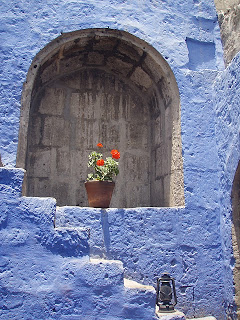Arequipa, meaning the White City, has a lot (not surprisingly) of white
volcanic rock called sillar which was in abundance here.
Spanish Church - the Iglesia de la Compania - the facade
is covered in both Christian and Inca holy symbols to help
integrate the locals into a Catholic acceptance.
is covered in both Christian and Inca holy symbols to help
integrate the locals into a Catholic acceptance.
Santa Catalina Monastery - the laundry, the only place where the nuns
could gossip. With their hands they diverted the flow of clean water in
the central gully to fill the huge terracotta bowls, for their washing.
Avocado, I think
Sights in Arequipa
We used Arequipa as a base and for a few days visited the Colca Canyon ..
We used Arequipa as a base and for a few days visited the Colca Canyon ..
On route to the Colca Canyon, Alpaca herds. Even at this height of
about 10,500 feet there were flamingos feeding in the distant wetlands.
There were also some unusual ducks, some with blue bills, and waders.
about 10,500 feet there were flamingos feeding in the distant wetlands.
There were also some unusual ducks, some with blue bills, and waders.
Unfortunately those pics were lost
At the Colca pass (below) ...
This is a rare kind of moss, I think only found here at high altitude (16,000 feet). It looks
lovely and soft but is hard as nails. Nigel may be able to remind me of its name :)
same, close up

The summit of the pass to the Colca Canyon
The Canyon is the world´s deepest, more than the Grand Canyon.
The Canyon is the world´s deepest, more than the Grand Canyon.
It´s popular with people hoping to see and photograph Condors.
watching out for Condors - we did see and photograph them,
but again the pics were lost.
but again the pics were lost.
We stayed in Chivay, in the Colca region. These were school-girls who spend several
hours each morning in January dancing roung the village square and fountain.
The dances are a means of preserving stories of their Inca past.
hours each morning in January dancing roung the village square and fountain.
The dances are a means of preserving stories of their Inca past.
History has it that the Spanish Conquistadores forced the men folk into nearby mines to dig for gold and kept them from their families. So the men tunneled their way back to the villages and when all the women suddenly appeared pregnant, the Spanish executed all the families - men women and children.
The Colca Valley - a rich and fertile area that the Incas acquired
from the previous occupants. They improved on the terracing and
Volcano on route to Cusco







 .
.









No comments:
Post a Comment